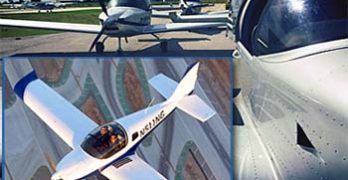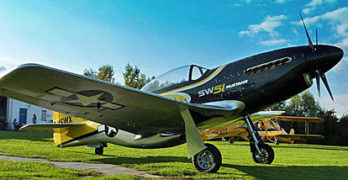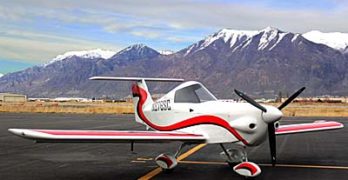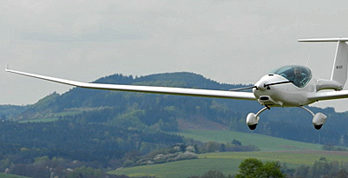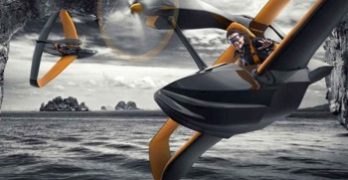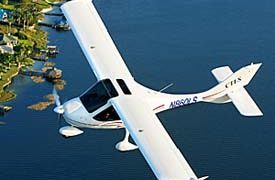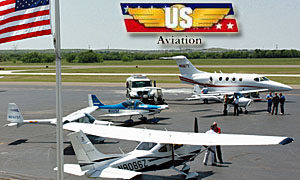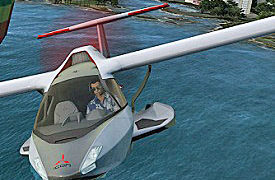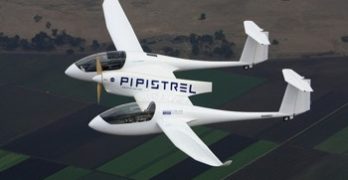One year ago Rotax announced a contest to award a brand-new 912 engine to the flight school that achieved the first time between overhaul (TBO) of 2,000 hours on a Rotax 912 iS model that the engine builder had just released. Upon reaching the goal, the flight school had to prove the hours by sending a copy of the logbook to their local distributor and then return the used engine to Rotax BRP in Austria.
At the end of January 2015, Rotax announced they had donated a copy of their newest Rotax 912 iS Sport engine to Madiba Bay School of Flight located in Port Elizabeth, Eastern Cape, South Africa. “Madiba Bay achieved the first time between overhauls (TBO) of 2,000 hours on their Sling 2 equipped with a Rotax 912 iS engine,” said representatives of the big Austrian engine manufacturer.
Flight school owner Gerhard Van Eeden said, “We are pleased to be the winner of a brand-new Rotax 912 iS Sport engine.
Search Results for : Flight Design
Not finding exactly what you expected? Try our advanced search option.
Select a manufacturer to go straight to all our content about that manufacturer.
Select an aircraft model to go straight to all our content about that model.
FK Lightplanes/ScaleWings SW51 Makes Maiden Flight
(This article has been updated in June 2018 to reflect a new manufacturer.)
At Aero 2013, I covered one of the most interesting replica airplanes I have ever seen in many years of scouring airshows for light aircraft of interest. My videographer and I did a video story about this exciting project. The airplane was again displayed at Aero 2014 though not in such a high traffic location but that hardly dampened enthusiasm. No question … FK Lightplanes continued their approach of great showmanship in displaying the most authentically realistic reproduction of a 70% scale P-51 Mustang you can imagine. Most replicas have to approximate some qualities but FK Lightplanes and their design partner, Austria-based ScaleWings AeroTec, made what they are now calling SW51 into something different. It has detail beyond what you can envision without seeing the construction in person.
First named FK51, SW51 reproduces the 100,000 or so rivets and screws that put together an original World War II vintage P-51 Mustang.
SkyCraft Completes Flight Testing of Minisport LSA
“After a long winter and spring dodging the Utah weather,” SkyCraft Airplanes announced that their SD-1 Minisport, “has completed flight testing successfully, meeting all the performance requirements needed for SLSA Certification.” The Orem, Utah company reported, “The plane was found to have good longitudinal and latitudinal stability and exhibited no issues with flutter, vibrations, or dangerous stall/spin tendencies.” SkyCraft representatives said they were able to verify the performance specifications for the SD-1 achieved by its Czech designers (see video below for a performance hint using a European aircraft). SkyCraft said that following the flight test regimen, they posted updated specifications on the Minisport page.
Minisport has been flying in Europe since 2007 when the airplane and company were created by designer Igor Spacek. The U.S. team first contemplated a kit aircraft — SD-1 Minisport is constructed significantly of wood making it a great project for some craftsmen — but later elected to go the fully-built Special LSA route.
Flight Report: UL Power 350 in the S-7S
Rans designer Randy Schlitter is one of those restlessly creative types. Many aviators are aware he’s created twenty airplane designs and these are not all variations on a theme. While a few are based on another, several are completely fresh approaches. Way back when, we used to joke about the Rans design-of-the-month club, so often did he emerge at an airshow with somethings we’d never seen. If that’s not enough he’s also been making bicycles for a few decades. (My wife and I each ride one and love them.) He runs Rans Aircraft and Rans Bicycles as side-by-side enterprises. Still not content, Randy does a bit of writing and has produced some artwork. My advice for most folks: don’t try to keep up. Randy is likely to leave you far behind. So, when I saw an installment of his “Into the Flight” series — this one after flying one of his S-7 Couriers with a UL Power 350 engine installed — I asked if I could reprint it here.
Long, Lovely Wings … Even Longer Flight
I think Phoenix is one the loveliest aircraft in the LSA fleet. Of course, I have a rather large bias as I’m a soaring enthusiast and this is one fine soaring machine in the SLSA fleet, able to compete fairly with a pure glider. I’m also a fan of importer Jim Lee, a modest, soft spoken man with a deep honesty streak. He’s also a world-renown soaring champion. Yet what just catches my eye again and again are the long, lovely, shapely, slippery wings of Phoenix, which lead me to present the photos you see with this article.
These views came from Jim’s long flight from his home base not far from mine in Melbourne, Florida to Bogota, Columbia. That meant a long water crossing from Key West to the Mexican coast, then south to Belize and on around to his destination (see route map). Jim wrote a blog of this entire experience featuring many photos and I’ll bet most pilots would like to read it.
Flynano Makes First Flight!
This is pretty cool, I have to say: a flying…what, waterbike? Winged pontoon? Powered box kite? Here’s the home page for *** Flynano: and doesn’t this supremely giddy pilot in the illustration remind you of U2′s Bono? Hmmm…backer? Person of Interest? Is Lindsay Lohan going to buy one? Stay tuned… *** A year ago, I wrote about these enterprising and clever folks behind the Flynano project. They made a (cue: drum roll) big splash at Europe’s 2011 Aero show when they introduced the mockup. Frankly, I confess to a tad of private skepticism: it looked like a long shot to ever fly, let alone actually come to market. That’s why I try to curb my public expressions of criticism: it’s so easy to be proven wrong. *** I was concerned that although the boxwing concept — a joined upper/lower wing, tailless design — has been proven, (and even marketed in Europe as the Sunny Boxwing, see video at bottom), the Flynano could easily have been just another blue-sky, briefly-ballyhooed project, like so many that have come down the pike (do the name Moeller Aircar ring a familiar note?) *** Yet how cool indeed ‘twould be if this easy-fly skimmer-bug of a recreational aircraft that only operates from the water could actually fly?
Flight School Dilemma… One Solution
Anyone who has tried to borrow money in the last five years knows how tough it has become. Banks supported by government guarantees practically gave money away before the subprime meltdown but are now being much more careful. That’s a good thing but it means even some credit-worthy customers can’t get the loan they need. Commonly rejected are flight schools. Flight training enterprises across the nation are struggling to obtain financing to buy new aircraft to replace aging fleets of trainers.
*** Despite the challenges, one LSA outfit has found at least a partial answer. Thanks to a solid customer (and onetime dealer), Flight Design USA has been able to offer a limited number of schools a method called leaseback. Training students today are three leased back CTLS Light-Sport Aircraft but this business success is only one part of a genuine human interest story.
*** “We are pleased to announce the third CTLS leased to a flight school was used by Iraq war veteran Adam Kisielewski, an Able Flight scholarship recipient who recently earned his Sport Pilot certificate,” said Tom Peghiny of Flight Design USA.
A Tale of Two Flight Schools…
Flight schools —- like many private buyers — are hyperfocused on, “What does an aircraft cost to operate?” Busy flight schools operating at high volume simply must track how all the pennies add up. In this article we asked US Aviation’s Scott Severen for info (based on an earlier post). Why US Aviation? While much of aviation has been down in the dumps, this Texas operation has been growing rapidly. Everybody is else down. They’re up. How to explain? Could it be the company’s willingness to embrace change?
*** “Many factors drive the operational experience and maintenance costs in flight school,” wrote Scott. “If a facility is set up for a particular type of aircraft, with flight instructors knowing the aircraft intimately, with experienced mechanics well trained in the upkeep of that aircraft, and a parts department with well-established suppliers, then you can create a business model to work very efficiently.
Microsoft Embraces Light-Sport — New Flight!
Today, Microsoft announced the return of Flight Simulator, once one of the best-selling games on computers. Well, in truth, it’s no longer called Flight Simulator, rather simply “Flight.” *** In 2009 Microsoft abruptly dropped Flight Sim, leaving only the techy X-Plane for digital joystick jockeys. It’s way above my pay grade to understand while the Microsoft billionaires dropped a good seller but, who cares? It’s back with one Great Big Surprise: The iconic Icon A5 LSA seaplane is the default aircraft and shows even titanic Microsoft sees where the action is in aviation. The other two aircraft coming with Flight are an RV-6 and a Boeing Stearman, a significant change from the Cessna 172 or bizjet of Flight Sim. *** “Microsoft Flight drops the ‘Simulator’ label for what its developer unabashedly dubs a game — and a free one at that,” wrote Mark Hachman for PC Magazine online.
Green Flight Challenge A Teachable Moment
Posting from Istanbul, Turkey where I’m on vacation with my family, but just couldn’t wait another day to talk a bit about what most everybody in aviation’s been talking about these last several days: the CAFE Green Flight Challenge (GFC). *** History was made when the Pipistrel Taurus Electro G4 twin-fuselage electric-powered aircraft carried four adults, around 1000 lbs. of batteries, one electric motor with a bit prop, and a lot of engineering and piloting savvy to victory in the GFC. They earned themselves $1.35 million in the process. Huge and well-deserved congratulations to Pipistrel!But for my money, the deeper story is not just that they flew off with the biggest aviation dollar prize ever, or even that they accomplished the task of flying 200 miles on one battery charge while also averaging more than 100 mph for the entire flight, or that they did it while “burning” the equivalent of 1 gallon of gas per passenger, or four gallons total…but…that they accomplished all that yet consumed the equivalent of around 1/2 gallon of gas per passenger!
- « Previous Page
- 1
- …
- 7
- 8
- 9
- 10
- 11
- …
- 147
- Next Page »


